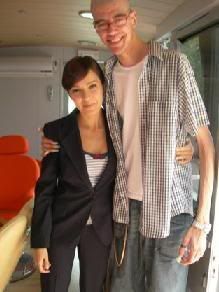 Marfan Syndrome is a genetic disease that affects the body's cconnective tissue.
Marfan Syndrome is a genetic disease that affects the body's cconnective tissue.Symptoms of Marfan Syndrome include:
Heart and Blood Vessels (Cardiovascular system):
*Enlarged or bulging aorta, the main blood vessel that carries blood from the heart (aortic dilation or aneurysm)
Separation of the layers of the aorta that can cause it to tear (aortic dissection)
“Floppy” mitral valve (mitral valve prolapse – MVP)
*= lethal
Bones and Joints (Skeletal system) :
Long arms and legs
Tall and thin body type
Curvature of the spine (scoliosis or kyphosis)
Chest sinks in (pectus excavatum) or sticks out/pigeon breast (pectus carinatum)
Long, thin fingers
Flexible joints
Flat feet
Teeth that are too crowded
Eyes (Ocular system):
Severe nearsightedness (myopia)
Dislocated lens of the eye
Detached retina
Early glaucoma
Early cataracts
Other Body Systems:
Stretch marks on the skin, not explained by pregnancy or weight gain
Sudden collapse of the lung (spontaneous pneumothorax)
Swelling of the sac around the spinal column (dural ectasia). This is found with CT or MRI scans of the back
The fibrillin-1 gene, on chronosome 15, is the gene that carries Marfan Syndrome.
The disorder is autosomal dominant, which means that it is not sex-linked and is a dominant allele. This disorder is genetically inherited only 75% of the time. In the other 25% of cases, it appears as the result of mutation.
This disorder can appear at any time during life.
This disorder occurs in offspring 50% of the time. The environment and other genese do not affect the expression of the disorder.
Diagnosis:
Marfan Syndrome can only be diagnosed if a doctor see symptoms in three or more body symptoms. While genetic tests may help confirm a diagnosis, they cannot diagnose the disorder without other data.
The disorder cannot be detected before birth with ceartainty. It may, however, be detected at birth.
The only way parents can check to see if they are carriers is to get an examination to see if they have three or more symptoms of the disdorder.
The only way to lessen the severity of this disease is to refrain from strenuous activities, as they may damage the aorta, an important heart muscle, which is already weakened by this disorder.
Quiz:
1. Is Marfan Syndrome dominant or recessive?
2. What are thre body systems that Marfan Syndrome affects?
3. What is the most lethal symptom of Marfan Syndrome?
4. Is Marfan Syndrome always inherited?
5. What tissue does Marfan Syndrome affect?
http://www.marfan.org/ : A foundation that supports Marfan Syndrome.
http://video.google.com/videoplay?docid=3856773959164642710 : video uplink
Bibliography:
http://www.lpch.org/DiseaseHealthInfo/HealthLibrary/genetics/autosom.html
http://www.marfan.org/marfan




